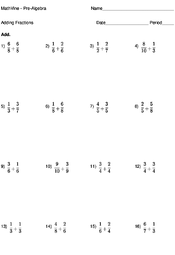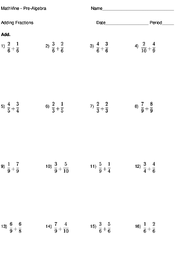Adding Fractions and Mixed Numbers
Introduction
In order to add fractions together, we find the highest common factor of the denominator, and add the equivalent numerators together.
Terms
Lesson
When adding fractions together, we have to make sure the denominators are the same. So if we are given , in this case the denominators are the same, so we simply add the two numerators together:
When the denominators are different, we ‘make’ them the same by finding their lowest common multiple. So in the case of , the LCM of 3 and 7 is 21. So we need to make the denominator of each fraction equal to 21.
These fractions now have the same denominators, so we simply add the numerators
So we know that
When adding mixed fractions, we follow the same procedure but we need to convert the mixed fraction to an improper fraction first.
So if we are given , we convert to the improper fraction . Then we ‘make’ the denominators the same by finding the LCM, so we end up with:
Since the denominators are now the same, we add the numerators together:


